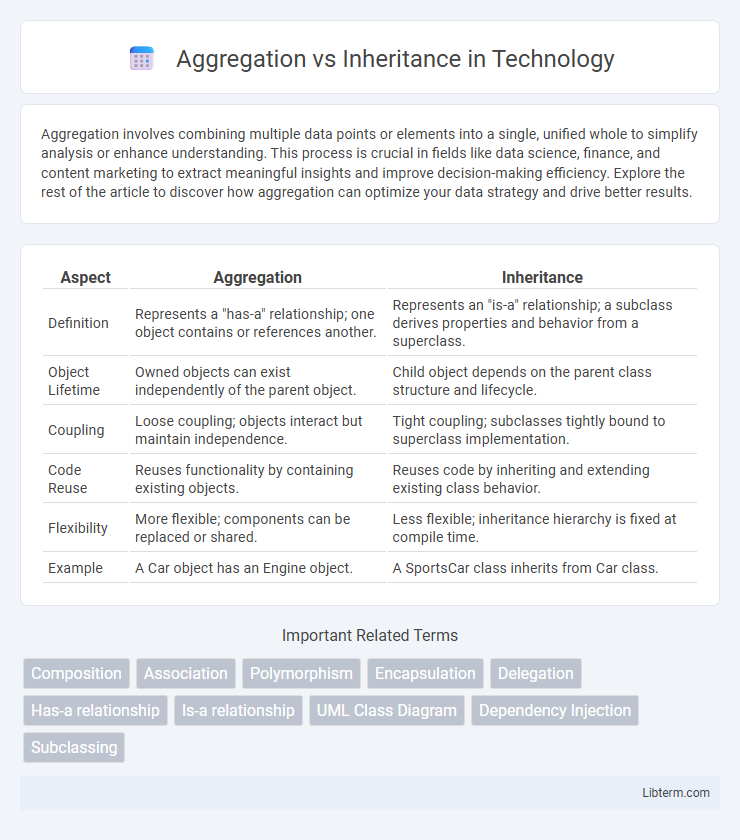Aggregation involves combining multiple data points or elements into a single, unified whole to simplify analysis or enhance understanding. This process is crucial in fields like data science, finance, and content marketing to extract meaningful insights and improve decision-making efficiency. Explore the rest of the article to discover how aggregation can optimize your data strategy and drive better results.
Table of Comparison
| Aspect | Aggregation | Inheritance |
|---|---|---|
| Definition | Represents a "has-a" relationship; one object contains or references another. | Represents an "is-a" relationship; a subclass derives properties and behavior from a superclass. |
| Object Lifetime | Owned objects can exist independently of the parent object. | Child object depends on the parent class structure and lifecycle. |
| Coupling | Loose coupling; objects interact but maintain independence. | Tight coupling; subclasses tightly bound to superclass implementation. |
| Code Reuse | Reuses functionality by containing existing objects. | Reuses code by inheriting and extending existing class behavior. |
| Flexibility | More flexible; components can be replaced or shared. | Less flexible; inheritance hierarchy is fixed at compile time. |
| Example | A Car object has an Engine object. | A SportsCar class inherits from Car class. |
Introduction to Aggregation and Inheritance
Aggregation represents a "has-a" relationship where an object contains or is composed of other objects, enabling modular and reusable code structures. Inheritance defines an "is-a" relationship allowing a subclass to inherit properties and methods from a superclass, promoting code reuse and polymorphism. Both concepts are fundamental in object-oriented programming for structuring complex systems efficiently.
Defining Aggregation in Object-Oriented Programming
Aggregation in object-oriented programming represents a "has-a" relationship where one class contains references to objects of another class, allowing shared ownership without strong dependency. Unlike inheritance, aggregation models a whole-part hierarchy where the lifecycle of the contained objects is independent from the container. This enables modular design by promoting loose coupling and reusability of components across different classes.
Understanding Inheritance in Object-Oriented Programming
Inheritance in Object-Oriented Programming enables a class to derive properties and behaviors from another class, promoting code reusability and hierarchical relationships. It allows subclasses to override or extend the functionalities of parent classes, facilitating polymorphism and dynamic method dispatch. Understanding inheritance is crucial for designing maintainable and scalable software architectures using languages like Java, C++, or Python.
Key Differences Between Aggregation and Inheritance
Aggregation represents a "has-a" relationship where one class contains a reference to another, allowing for independent lifecycles, while inheritance establishes an "is-a" relationship enabling a subclass to acquire properties and behaviors from a superclass. In aggregation, the contained object can exist independently of the container, promoting loose coupling, whereas inheritance creates a tightly coupled hierarchy with strong dependency between parent and child classes. Aggregation supports composition and flexibility by enabling dynamic association, whereas inheritance enforces static hierarchy and reuse through code extension.
Practical Examples of Aggregation
Aggregation represents a "has-a" relationship where one object contains or references another without implying ownership, such as a university having multiple departments. For instance, a car class can aggregate an engine class, indicating the engine is part of the car but can exist independently. In contrast to inheritance, aggregation emphasizes compositional connections enabling more flexible and reusable designs in object-oriented programming.
Real-world Use Cases of Inheritance
Inheritance is widely utilized in software design to model real-world hierarchies, such as a Vehicle superclass with Car and Truck subclasses that inherit common attributes like speed and capacity while adding specific features. It enables code reusability and polymorphism, allowing developers to create specialized objects without duplicating code--for instance, a Bird class inheriting from Animal, with methods for flying and chirping. Inheritance is essential in UI frameworks where a basic Widget class is extended by Button, TextBox, and CheckBox components, streamlining the creation of diverse interface elements sharing core behaviors.
Pros and Cons of Aggregation
Aggregation promotes loose coupling by allowing objects to exist independently while establishing a whole-part relationship, which enhances flexibility and reusability in object-oriented design. It offers better control over the lifecycle of components compared to inheritance, reducing the risk of unintended side effects during object modification or deletion. However, aggregation can complicate code management due to the increased need for explicit handling of component interactions and dependencies.
Advantages and Disadvantages of Inheritance
Inheritance allows for code reuse by enabling new classes to inherit properties and methods from existing ones, reducing redundancy and promoting a hierarchical organization of related classes. However, inheritance can lead to tight coupling between base and derived classes, making changes in the parent class potentially disruptive to subclasses and complicating maintenance. Overusing inheritance may result in rigid class structures and difficulties in refactoring, whereas aggregation provides more flexibility by composing objects at runtime without the constraints of a strict hierarchy.
When to Use Aggregation vs Inheritance
Use aggregation when modeling a "has-a" relationship where the child object can exist independently of the parent, such as a "Car" having "Wheels." Inheritance is suitable for an "is-a" relationship where the subclass shares a common structure or behavior with the superclass, like a "Dog" inheriting from an "Animal." Choose aggregation to promote loose coupling and reuse components, while inheritance fits situations requiring polymorphism and extension of existing functionality.
Best Practices for Choosing Between Aggregation and Inheritance
Best practices for choosing between aggregation and inheritance emphasize using inheritance to model "is-a" relationships where a subclass shares a strong, hierarchical relationship with the superclass, enabling code reuse and polymorphism. Aggregation suits "has-a" relationships, allowing for flexible and modular designs by composing objects with distinct lifecycles and responsibilities, promoting loose coupling and easier maintenance. Choosing the right approach depends on understanding object dependencies, avoiding overuse of inheritance to prevent rigid designs, and favoring aggregation for greater extensibility and clearer responsibility delegation.
Aggregation Infographic

 libterm.com
libterm.com